 W
WArja, also known as Balinese opera, is a popular form of Balinese theatre which combines elements of opera, dance, and drama. It was created in 1825 for the funeral of a Balinese prince. In the beginning it had an all-male cast; since the 20th century all performers have been women.
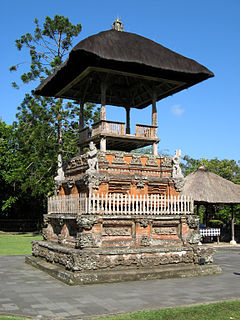 W
WThe bale kulkul or bale kul-kul is a Balinese pavilion where a slit-log drum is placed. It is essentially a drum tower or a watch tower. A bale kulkul can has a civic function, such as those used in villages as a mean of communication; or for religious function, an integral part of Balinese temple architecture.
 W
WThe Bali Kite Festival is an annual international kite festival held in July in Padang Galak area, Sanur Beach, Bali. Traditional giant kites are made and flown competitively by teams from the villages (banjar) of Denpasar. The event is a seasonal religious festival intended to send a thanking message to the Hindu gods to create abundant crops and harvests.
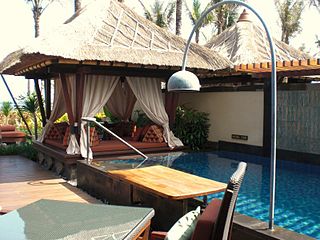 W
WBalinese architecture is a vernacular architecture tradition of Balinese people that inhabits volcanic island of Bali, Indonesia. The Balinese architecture is a centuries-old architectural tradition influenced by Balinese culture developed from Hindu influences through ancient Javanese intermediary, as well as pre-Hindu elements of native Balinese architecture.
 W
WBalinese dance is an ancient dance tradition that is part of the religious and artistic expression among the Balinese people of Bali island, Indonesia. Balinese dance is dynamic, angular and intensely expressive. Balinese dancers express the stories of dance-drama through the bodily gestures including gestures of fingers, hands, head and eyes.
 W
WBalinese is a Malayo-Polynesian language spoken by 3.3 million people on the Indonesian island of Bali as well as Northern Nusa Penida, Western Lombok, Eastern Java, Southern Sumatra, and Sulawesi. Most Balinese speakers also know Indonesian. The Bali Cultural Agency estimated in 2011 that the number of people still using the Balinese language in their daily lives on the Bali Island is under 1 million. The language has been classified as "not endangered" by Glottolog.
 W
WThe Balinese people are an Southeast Asian ethnic group and nation native to the Indonesian island of Bali. The Balinese population of 4.2 million live mostly on the island of Bali, making up 89% of the island's population. There are also significant populations on the island of Lombok and in the easternmost regions of Java.
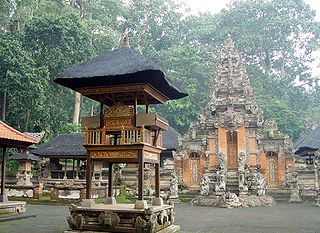 W
WA pura is a Balinese Hindu temple, and the place of worship for adherents of Balinese Hinduism in Indonesia. Puras are built in accordance to rules, style, guidance and rituals found in Balinese architecture. Most puras are found on the island of Bali, where Hinduism is the predominant religion; however many puras exist in other parts of Indonesia where significant numbers of Balinese people reside. Mother Temple of Besakih is the most important, largest and holiest temple in Bali. Many puras have been built in Bali, leading it to be titled "the Island of a Thousand Puras".
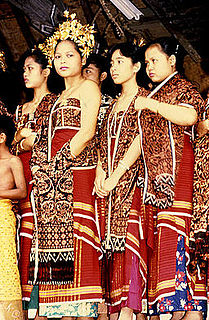 W
WBalinese textiles are reflective of the historical traditions of Bali. Bali has been historically linked to the major courts of Java before the 10th century; and following the defeat of the Majapahit kingdom, many of the Javanese aristocracy fled to Bali and the traditions were continued. Bali therefore may be seen as a repository not only of its own arts but those of Java in the pre-Islamic 15th century. Any attempt to definitively describe Balinese textiles and their use is doomed to be incomplete. The use of textile is a living tradition and so is in constant change. It will also vary from one district to another. For the most part old cloth are not venerated for their age. New is much better. In the tropics cloth rapidly deteriorates and so virtue is generated by replacing them.
 W
WBalinese theatre and dramas include Janger dance, pendet dance performances and masked performances of Topèng. Performances are also part of funeral rituals involving a procession, war dance, and other rituals before the cremation of the patulangan. Balinese use the word sesolahan for both theatre and dance.Arja (dance), Balinese dance-opera Barong dance performances featuring Rangda, a dancer with keris, Jero Gede and Jero Luh Barong Ket: lion barong, the most common Barong, it is the symbol of a good spirit. Barong Landung: giant barong, the form is similar to Betawi Ondel-ondel Barong Celeng: boar barong Barong Macan: tiger barong Barong Naga: dragon Gambuh, plays with chanting and music including the use of long flute like instruments Topèng, masked theatre Calonarang, performances at temples during times of danger or difficulty that involve stories Drama Gong, popular theatre developed in the late 1960s Sendratari, a group ballet form that emerged in the 1960s that includes a dhalang puppeteer giving dialogue and often a gamelan (orchestra), Sendratari or Kècak chant
 W
WBalinese traditional house refers to the traditional vernacular house of Balinese people in Bali, Indonesia. The Balinese traditional house follows a strict ancient of bali architectural guide which is a product of a blend of Hindu and Buddhist beliefs, fused with Austronesian animism, resulting in a house that is "in harmony" with the law of the cosmos of Balinese Hinduism.
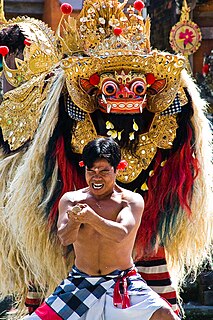 W
WBarong dance is a style of traditional Balinese and Javanese dance from Bali and Java. The dance demonstrates about the mythological depiction of animals that have supernatural powers and could protect humans. Barong is the king of the spirits, leader of the hosts of good, and enemy of Rangda, the demon queen and mother of all spirit guarders in the mythological traditions of Bali. The Barong dance featured battle between Barong and Rangda to represent the eternal battle between good and evil.
 W
WBlakas or Belakas is a general name for any sort of cleaver or large knife originating from Bali, Indonesia that has a heavy rectangular blade with a straight cutting edge used for chopping. The long, rounded hilt often becomes thinner at one or both ends. The blade often has a fanciful shape and encrusted motifs. Sometimes it is made for ceremonial purposes, and also used in pairs with golok. It is a common utensil in Balinese households and is used for kitchen chores, orchard work, and in ceremonial activities.
 W
WCanang sari is one of the daily offerings made by Balinese Hindus to thank the Sang Hyang Widhi Wasa in praise and prayer. Canang sari will be seen in the Balinese temples (pura), on small shrines in houses, and on the ground or as a part of a larger offering.
 W
WCandi bentar, or split gateway, is a classical Javanese and Balinese gateway entrance commonly found at the entrance of religious compounds, kraton palaces, or cemeteries in Indonesia. It is basically a candi-like structure split perfectly in two to create a passage in the center for people to walk through. The passage is usually elevated with a flight of stairs to reach it. A candi bentar is commonly found in Java, Bali, and Lombok.
 W
WBalinese cuisine is a cuisine tradition of Balinese people from the volcanic island of Bali. Using a variety of spices, blended with the fresh vegetables, meat and fish. Part of Indonesian cuisine, it demonstrates indigenous traditions, as well as influences from other Indonesian regional cuisine, Chinese and Indian. The island's inhabitants are predominantly Hindu and culinary traditions are somewhat distinct with the rest of Indonesia, with festivals and religious celebrations including many special foods prepared as the offerings for the deities, as well as other dishes consumed communally during the celebrations.
 W
WGandrung is a traditional dance from Indonesia. Gandrung has many variations and is popular in Bali, Lombok and Eastern Java among the Balinese, Sasak and Javanese. The most popular variation is gandrung from the Banyuwangi region in the eastern peninsula of Java, so much that the city is often referred as Kota Gandrung or "the city of gandrung".
 W
WGedong Kirtya library was founded in 1928 by the Dutch in what was then their colonial capital of the Lesser Sunda Islands, Singaraja, and named for the Sanskrit word 'to try'. It is in the complex of Sasana Budaya, the old palace of the Buleleng Kingdom.
 W
WJanger dance is one of the most popular dances from Bali, Indonesia The term roughly translates to '"infatuation," with a connotation of someone who is madly in love” :97
 W
WJoged dance is a style of dance from the Island of Bali derived from the traditional Gandrung dance. The term joged or joget is also a common word for dance in Indonesia. The dance is typically accompanied by a gamelan ensemble of bamboo instruments called a gamelan joged bumbung. Dancers usually wear attire consisting of a Kebaya and Sarong Unlike most Balinese dance, joged is not a religious and ritual one, it is a secular social dance for entertainment purposes only. During a joged performance, a single or several female dancers will perform for usually predominantly male audience to dance with them. Dancers may often invite a spectator to join in the joged using a fan and sash. which unlike many dances has no set moves and is largely improvised. It is considered impolite to refuse such an invitation.
 W
WKecak, known in Indonesian as tari kecak, is a form of Balinese Hindu dance and music drama that was developed in the 1930s in Bali, Indonesia. Since its creation, it has been performed primarily by men, with the first women's kecak group having started in 2006. The dance is based on the story of the Ramayana and is traditionally performed in temples and villages across Bali.
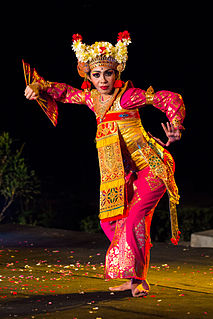 W
WLegong is a form of Balinese dance. It is a refined dance form characterized by intricate finger movements, complicated footwork, and expressive gestures and facial expressions.
 W
WLudruk is one of the theatrical genres in East Java. It is a form of traditional performance presented by a troupe of actors on a stage, re-telling the life stories of everyday people and their struggles. Its origin is unclear, but it is believed to be dated as far back as the 13th century.
 W
WJegog is a form of gamelan music indigenous to Bali, Indonesia, played on instruments made of bamboo. The tradition of jegog is centered in Jembrana, a region in Western Bali. In recent years jegog has started to become popular in other regions of Bali with a few groups being established in central Bali to entertain tourists. International interest has been spread by tourists visiting Bali and by recordings. There are virtually no ensembles outside of Bali with the exception of at least two groups in Japan, one in the United States and one in Germany. Jegog music is very fast, loud, rhythmic and precise. Pieces last from a few minutes to as long as thirty minutes.
 W
WA Meru tower or pelinggih meru is the principal shrine of a Balinese temple. It is a wooden, pagoda-like structure with a masonry base, a wooden chamber and multi-tiered thatched roofs. The height of Meru towers represent the Hindu Mount Meru. Meru towers are usually dedicated to either the highest gods of the Hindu pantheon, the local pantheon, or a deified person.
 W
WNgaben, also known as Pitra Yadyna, Pelebon or cremation ceremony, is the Hindu funeral ritual of Bali, Indonesia. A Ngaben is performed to release the soul of a dead person so that it can enter the upper realm where it can wait for it to be reborn or become liberated from the cycles of rebirths. The Balinese Hindu theology holds that there is a competition between evil residents of the lower realm to capture this soul, and a proper cremation enhances the chance that it may reach the upper realm.
 W
WPaduraksa, also known as kori is a type of gateway covered with towering roof that can be found in the island of Java and Bali, Indonesia. This architectural feature is commonly found in buildings from the classical Hindu-Buddhist period of Indonesia. Paduraksa marks the threshold into the most sacred space within a religious compound, a cemetery, or a palace. In Balinese architecture, an elaborately decorated towering paduraksa is often built as the temple's most imposing structure.
 W
WPendet dance is a traditional dance from Bali, Indonesia, in which floral offerings are made to purify the temple or theater as a prelude to ceremonies or other dances. Pendet is typically performed by young girls, carrying bowls of flower petals, handfuls of which are cast into the air at various times in the dance. Pendet can be thought of as a dance of greeting, to welcome the audience and invite spirits to enjoy a performance. It is one of the oldest Balinese dance, although the current form was codified in the 1950s.
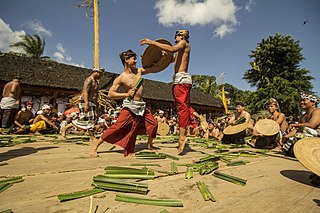 W
WPerang pandan is a Balinese tradition of ritual combat with clubs made of pandan. It is known in the Balinese language as mageret pandan or makare-kare. Perang pandan is practiced by the Bali Aga population of Tenganan village in Karangasem Regency, Indonesia. The people of Tenganan are devotees of the deity Indra. To honour Indra as a warrior god, many major religious festivals in Tenganan involve a ritualistic battle.
 W
WSanghyang is a sacred Balinese dance based on the premise that an unseen force enters the body of an entranced performer. The force, identified as hyang, is an important type of spiritual entity in ancient Indonesian mythology.
 W
WTenganan Pegringsingan or Pageringsingan is a village in the regency of Karangasem in East Bali, Indonesia. Before the 1970s was known by anthropologists to be a secluded society in the archipelago.
 W
WTrance and Dance in Bali is a short documentary film shot by the anthropologists Margaret Mead and Gregory Bateson during their visits to Bali in the 1930s. It shows female dancers with sharp kris daggers dancing in trance, eventually stabbing themselves without injury. The film was not released until 1952. It has attracted comment from later anthropologists for its pioneering achievement, but also for what it does not show.
 W
WTrunyan or Terunyan is a Balinese village (banjar) located on the eastern shore of Lake Batur, a caldera lake in Bangli Regency, central Bali, Indonesia. The village is one of the most notable homes of the Bali Aga people, the others being the villages of Tenganan and Sambiran. Trunyan is notable for its peculiar treatment of dead bodies, in which they are placed openly on the ground, simply covered with cloth and bamboo canopies, and left to decompose. The influence of a nearby tree is said to remove the putrid smell of the corpses.
 W
WUmbul-umbul, also called rérontek or, archaically, tunggul, are a type of flag or pennant made of a strip of cloth whose longer side is attached to a pole. They are used in the traditional culture of Java and Bali, Indonesia, where they are carried in festivals and serve other decorative purposes. Red and white Umbul-umbuls are raised throughout Indonesia along streets in August to commemorate the Indonesian independence day.
 W
WA wantilan is a Balinese pavilion (bale) used for activities involving large crowds. A wantilan is the largest type of bale in Balinese architecture. A wantilan is basically a large wall-less hall placed under a large multi-tiered roof. A wantilan as a public building is usually located at a village's main square or main junction and functions as an open hall to hold large community activities such as meeting halls or a public musical gamelan performance. A wantilan is also a religious building, an integral part of Balinese temples used to hold the Balinese cockfighting ceremony.
 W
WWedung is a traditional large knife of the Javanese people and the Balinese people originating from Indonesia.